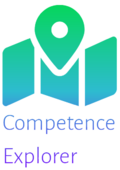Elements of a Learning Process
A learning process consists of the standard elements described in detail in the During section. No matter if it lasts several days, several hours, or only one hour, the working conditions need to be clarified and created, or learners need to be enabled to involve their qualities, curiosity and expertise.
At several stages of a longer process they also need opportunities to reflection on their needs, questions and experiences, and also to assess their learning during the process (formative evaluation).
A final evaluation focuses on the learning outcome, its relevance for their future and on the evaluation of the learning process they were involved in. Finally, learners and facilitators need to describe learning outcome or competence development.
Process Dynamics that Influence the Learning Experience
Planning a workshop or seminar means taking into account different structuring logics. These complement each other in places, but sometimes they also contradict each other. The learning as an activity is curricular, the group dynamics is evolving during the process. A topical concept is promoting a logical structure. Creative thinking requires methodological alternation. A way must be found to integrate these logics appropriately.
#1 Nonlinear and curricular Nature of Learning
The first is the curricular nature of learning in a nonlinear process - between experience, reflection and conceptualization. A process needs to foresee place for regular experience and regular reflection/assessment/reasoning.
#2 Divergence and Convergence
Second, a learning process is oscillating between two opposite ways of thinking. Divergent thinking opens the mind to different impulses - rather open-ended and explorative. Convergent thinking is narrowing our thinking. It's logical and directed toward a conclusion or result. The interplay between divergence and convergence characterizes the whole process and also explains the dynamics in smaller units on a micro-level. One approach to satisfy dimensions is to mix and alternate methodology.
#3 Content Order
#4 Group Dynamics
Fourth, the group dynamics need to be taken into consideration. In particular, when a group is starting together, the phases of group development claim their space from group formation to storming, then norming toward finding into a performing mode. In order to achieve this, consider the idea of Cooperative Learning, team building measures at the beginning and recognize, that probably higher group performance will be possible during the later steps of a process.
#5 Competence development
Competence-oriented learning processes address equally the three dimensions cognition, emotion and practice (or head, heart and hand). At the end the workshop, lecture or longer educational programme should support the participants' acquisition of competences. Check:
- Do the planned elements address the most relevant specific (sub) competences - knowledge, attitudes, values, skills?
- Were the three dimensions addressed in a balanced way?
- Does this plan support self-development and offer enough opportunities to participation and co-creation?
Unit Planning
Planning a learning unit or a whole workshop is trying to satisfy diverse expectations. In example, there is the content of learning, a learner group has needs and is underlying a certain dynamic, or one has to make a choice regarding the methodology, how to facilitate the process. In detail these are questions such as:
Why Goals First?
The goals have priority in planning and content, topics, methods should fit into the goals. We explain, why it makes sense to plan by prioritizing goals and learning to give them priority:
Gaining Clarity
Goals help you to think about what you want to achieve and where you currently are in the process.
The disadvantage of thinking in methods, not in goals, is that you might not necessarily be able to describe the deeper meaning behind the unit you are teaching.
Being Transparent
Goals help you inform your participants about what you want to achieve and what is going happen.
Otherwise you have to offer them an explanation along the lines of: “We're playing a game – you'll understand later on.” This is not transparent.
Setting Criteria for Assessment/Evaluation
Goals establish your criteria for success. You will need them for further planning and for evaluation.
If you do not know what you want to achieve, then it is difficult to measure success.
Gaining More Flexibility for Participatory Interaction
Clear goals make you flexible and free to negotiate with your participants. They help you decide quickly whether the process is moving in the right direction or, you should stop or change.
When you have to change quickly, you can act more spontaneously and have more freedom to negotiate with your participants if you keep the "big picture" in mind.
Tool: Planning Matrix
A planning matrix focuses on the goals of your activity, is flexible enough to include spontaneous innovations, and reflects the participants’ needs and those of the facilitators. We recommend planning a meeting using such a goal-content-method table, which should cover all relevant information.
Define the general purpose of the meeting
First, describe the general issue you are dealing with in the meeting and how it is related to the general, fundamental goals of your activity. Before filling out the matrix define one general goal for the meeting with a maximum of 5 sub-goals. This reduction will help you to gain clarity.
- These or similar methods could help: Organise, sort and weight or Decision cake
Check also the competences you aim to adress by your training or workshop. Different competence frameworks could serve as a source of inspiration here.
Competence Frameworks as a Source of Inspiration
- A tool for an overview of different competence frameworks: Competence Explorer
- Scaffold Card Game by European Training Foundation
- Card Game: Competences for a Democratic Culture
Divide the programme in smaller timeslots (units)
Define the time necessary for each unit. Try to be realistic. Include breaks (which should be considered as necessary informal group, reflection or recreation time).
|
|
Example: |
11:00-12:30 |
Lunch break |
14:00-15:15 |
1. GoalsGo into details . Plan different units or didactical steps for the meeting and define their goals. Formulate the goals from the perspective of your participants, using the past tense. “The participants have learned/experienced/done...” |
Sub-unit A (9:00-9:45)
--- Sub-unit B (9:45-10:30) ... |
|||
2. ContentIdentify the relevant content. Which aspects of the content are important? What knowledge is relevant? |
Sub-unit A (9:00-9:45) Active icebreaking Possible Questions:
--- Sub-unit B (9:45-10:30) ... |
|||
3. MethodChoose a method: Methods have to correspond to their goals. While you choose from among several possibilities for how to teach a topic, you can ask: Which of the methods is best suited to achieve my goals? How will I achieve the goal and address the topical aspects? |
Sub-unit A (9:00-9:45) Shoe game
Sociometric line-up
--- Sub-unit B (9:45-10:30) ... |
|||
4. Who?A larger team can include one facilitator and a supporting co-facilitator. If you are running a meeting as a team, it makes sense to agree on goals, while the facilitator responsible for the unit decides on content and methods. Who plans, moderates or guides participants through the step(s)? |
Sub-unit A (9:00-9:45)
--- Sub-unit B (9:45-10:30) |
|||
5. Material and remarksYou can also add the necessary material and organizational remarks to the table. This can be helpful during preparation. What materials, preparation or specific requirements are needed? |
Sub-unit A (9:00-9:45)
--- Sub-unit B (9:45-10:30) |
|||
6. Check: Addressed CompetencesWhat (sub)competence - knowledge, skills, attitudes, values- is addressed in here? Check: Competence Explorer |
Sub-unit A (9:00-9:45)
--- Sub-unit B (9:45-10:30) |
Flexibility: Between Goals and the Process
Striking a healthy balance between a goal-oriented and process-oriented approach is what makes a holistic learning experience complete, and reflects the values of holistic understanding. This means that we always have to be aware that changing plans might be necessary, and that you cannot completely stick to the seminar schedule you created beforehand.
When we agree on regular adjustments of our plans and learning goals, this implies that we have to discuss plans and goals with our participants transparently. In this sense, we encourage them to:
- Share tasks
- Decide together about changes in subjects, methods, or agendas
- Negotiate conflicting goals
- Ask themselves how we can ensure that plans have enough flexibility and yet also enough structure?
Possibilities for changing plans during an event
- Regular assessment in the facilitators' team: Having regular team meetings on the evening of the event
- Morning sessions: discussing program and goals with participants
- Encouraging participants’ reflection, e.g. regular reflection rounds without or with the facilitators, including methods for formative self-assessment
- Offering an anonymous feedback box and checking it before every daily programme
- Inviting participants to influence the process during the event and showing your willingness to do it: e.g. speeding up some parts if participants already have knowledge of it, taking breaks when participants say they need it, letting participants facilitate parts of a session, etc.
However, the condition for adjustments is reflection grounding on evidence gained by assessment - in a formative assessment/evaluation approach during the whole process.
Read more:
At the beginning, it might make us feel insecure to give up control, but experience shows that it actually strengthens participants’ sense of responsibility for the process and their identification with the seminar content.
Elke Heublein
Co-founder of Working Between Cultures. Co-author of Holistic learning. Facilitator since 2004, certified intercultural facilitator (Institute for Intercultural Communikation, LMU München) and trainer (IHK Akademie München/Westerham), adult education (Foundation University Hildesheim). Focus: Cooperation and leadership in heterogenouos teams, higher education, train-the-trainer.
Nils-Eyk Zimmermann
Editor of Competendo. He writes and works on the topics: active citizenship, civil society, digital transformation, non-formal and lifelong learning, capacity building. Coordinator of European projects, in example DIGIT-AL Digital Transformation in Adult Learning for Active Citizenship, DARE network.
Blogs here: Blog: Civil Resilience.
Email: nils.zimmermann@dare-network.eu
Handbook for Facilitators: Holistic Learning
E. Heublein (ed.), N. Zimmermann (ed.) (2017). Holistic learning. Planning experiential, inspirational and participatory learning processes. Competendo Handbook for Facilitators.





































